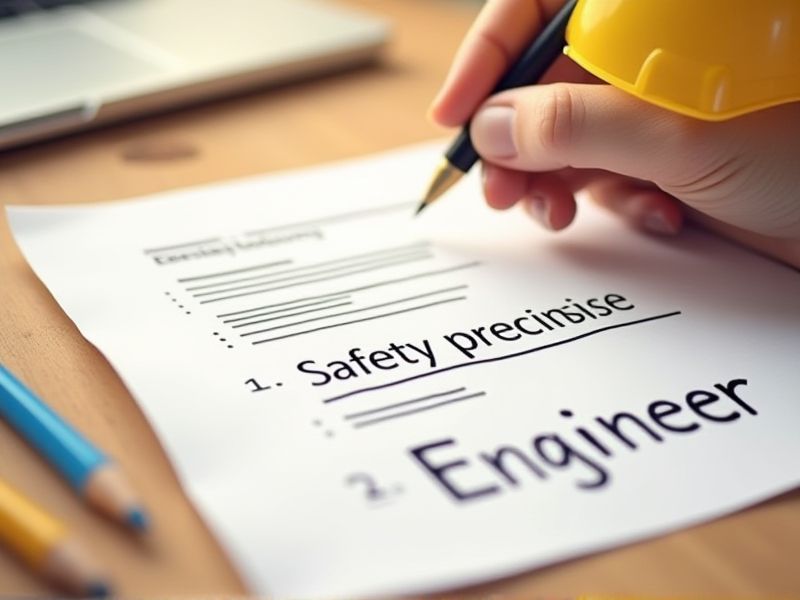
Safety Engineers mitigate risks and ensure compliance with safety standards, which requires both technical knowledge and practical expertise. Certain certifications validate a professional's capability to assess hazards, design safe processes, and implement preventive measures. Industry-recognized certifications also signify a commitment to maintaining the highest standards of safety. Here are some critical certifications you might need as a Safety Engineer.
Certified Safety Professional (CSP)
Certified Safety Professional (CSP) enhances a Safety Engineer's credibility, opening up more career opportunities and instilling confidence among employers and clients. With CSP designation, a Safety Engineer demonstrates proven expertise and a strong commitment to continuous professional development. Industries often require CSP certification due to stringent safety regulations, making it a valuable asset for compliance. Employers see reduced liability risks, as CSP-certified Safety Engineers are more adept at identifying and mitigating potential hazards.
Associate Safety Professional (ASP)
The Associate Safety Professional (ASP) credential verifies a Safety Engineer's foundational knowledge in occupational safety and health, promoting competence in risk assessment. Meeting ASP standards often results in improved workplace safety protocols, reducing incidents and liability. Employers tend to recognize ASP certification as a mark of dedication and expertise in the field, influencing hiring and promotion decisions. Over time, an ASP-certified Safety Engineer may drive more effective safety programs, enhancing organizational compliance with regulations.
NEBOSH International General Certificate in Occupational Health & Safety
Safety Engineers often work in diverse environments where understanding global safety standards is crucial; the NEBOSH International General Certificate provides this essential knowledge. This credential ensures Safety Engineers are equipped with the skills to identify and mitigate workplace hazards, significantly reducing the risk of accidents. Global recognition of NEBOSH standards can open international career opportunities for a Safety Engineer, enhancing professional credibility. Its comprehensive coverage of risk management and health practices directly influences safer workplace environments.
OSHA 30-Hour Training Certificate
A Safety Engineer requires the OSHA 30-Hour Training Certificate to gain a comprehensive understanding of workplace safety standards and regulations. This certification enhances their ability to identify and mitigate potential hazards in various work environments, leading to reduced accident rates. Employers often demand this certification to ensure compliance with federal safety standards, which meets legal and organizational safety requirements. The training fosters a culture of safety and awareness, equipping engineers with the necessary skills to implement effective safety protocols.
ISO 45001 Lead Auditor Certification
ISO 45001 Lead Auditor Certification equips safety engineers with the skills to assess and improve occupational health and safety management systems effectively. Having this certification enhances a safety engineer's credibility and aligns their competencies with international standards. Organizations benefit from reduced workplace hazards and incidents when employing certified professionals. This certification often increases career advancement opportunities by meeting industry demands for skilled auditors.
Certified Industrial Hygienist (CIH)
A Certified Industrial Hygienist (CIH) offers specialized expertise in identifying and evaluating workplace hazards, essential for a Safety Engineer to maintain a safe work environment. Their knowledge enhances the ability to implement effective control measures for potential health risks, like chemical or biological exposures. Collaboration between CIHs and Safety Engineers leads to comprehensive risk assessments, ensuring compliance with safety regulations. The presence of a CIH can improve overall workplace safety culture, reducing the incidence of occupational illnesses and injuries.
Construction Safety and Health Technician (CSHT)
Construction sites present numerous hazards, so a Construction Safety and Health Technician (CSHT) provides specialized knowledge to mitigate risks effectively. The CSHT supports the Safety Engineer by ensuring compliance with safety regulations and enhancing the implementation of safety protocols. Their expertise in health and safety assessments results in decreased accident rates, contributing to a safer work environment. When the CSHT alleviates some workload, the Safety Engineer can focus on strategic safety planning and addressing high-level safety concerns.
Six Sigma Green Belt Certification
A Safety Engineer with a Six Sigma Green Belt Certification can systematically reduce defects and improve safety processes through data-driven methodologies. Certification provides tools to identify and control potential hazards, minimizing workplace incidents. Mastering these techniques increases operational efficiency, leading to a safer work environment. Companies often require such qualifications to meet stringent safety standards and enhance risk management.
NFPA Certified Fire Protection Specialist (CFPS)
The NFPA Certified Fire Protection Specialist (CFPS) credential signifies a deep understanding of fire and life safety principles, which is crucial for a Safety Engineer to develop effective prevention and protection strategies. Gaining CFPS certification ensures that the Safety Engineer is equipped with the latest industry knowledge and practices, aligning their work with established safety standards. This certification enhances credibility and trust among stakeholders, facilitating collaboration on safety protocols and compliance. Possessing a CFPS can improve risk assessment abilities, allowing for the design of safer systems and reduction of potential fire-related incidents.
Certified Process Safety Professional (CPSP)
The CPSP certification elevates a Safety Engineer's expertise in identifying and mitigating potential hazards in industrial processes, thus contributing to safer workplaces. This certification validates an individual's comprehensive understanding of process safety, inherently building trust with employers and regulatory bodies. By standardizing advanced safety procedures, CPSP ensures consistent evaluation and management of risks, significantly reducing incidents. The evolving complexities in industrial systems necessitate specialized knowledge that CPSP provides, making it an essential credential in the field.
Summary
When you obtain certifications as a Safety Engineer, you gain enhanced credibility and demonstrate commitment to industry standards. This can lead to improved job prospects and possibly higher salary packages. Employers may have increased confidence in your skills, reducing workplace incidents. Your certified expertise can also foster a safer work environment, benefiting overall organizational efficiency.
